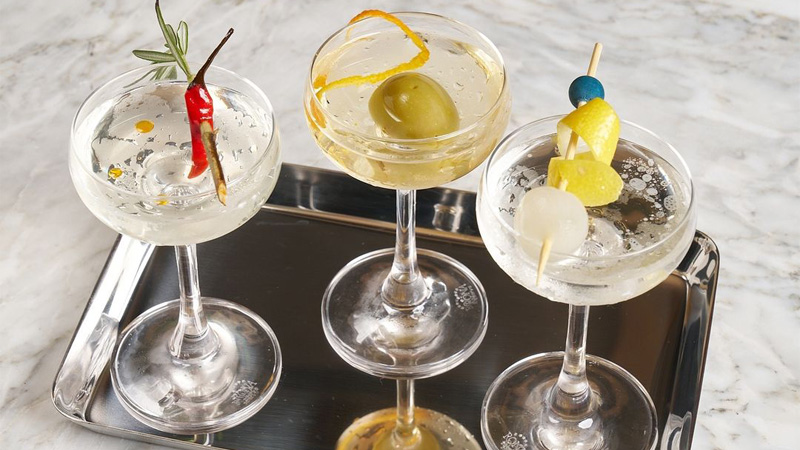Bar director Rob Krueger is charmed by the idea of a tiny Martini in a mini cocktail glass topped with a huge olive.
“That vision stuck with me,” he said of developing the beverage program at Smith & Mills, which opened its second location in Manhattan’s Rockefeller Center in late 2023. He toyed with the concept and landed on a trio of mini Martinis: a Vesper inspired by the popular large-format version from the original location, a smoky mezcal-based interpretation, and, yes, a gin Martini with a giant Spanish olive. The restaurant also serves rounds of mini Espresso Martinis.
“People absolutely love it,” Kruger says. “People love cute stuff.”
Cute may be an understatement. Smaller-format Martinis are popping up on cocktail menus at bars, restaurants, and even homes across the country. The idea is simple: Swap the standard 8-ounce Martini glass for a teenier equivalent — think a coupe, vintage glassware, a Nick and Nora — or any vessel that tempers the volume while still allowing for a garnish.
I was delighted to see a three-way take when I visited Smith & Mills, especially since I’ve been serving what I call “teeny tiny Tinis” in my own home regularly. For me, they’re a way to enjoy a Martini and imbibe less alcohol. For others, like my husband, they’re means of exploring variations of the cocktail instead of just having one. The mini drink fits the bill for various other applications, including educating consumers, viral social media marketing, and lower-ABV nightcaps on our own couches. It’s all a reflection of America’s changing drinking habits, and for many, that might no longer include a big cup of alcohol.
Honey, I Shrunk the Drinks
These miniatures go by several names on-premise, from the obvious play on words — Mar-tiny — to creative nomenclatures such as the Bambini (at Macchialina in Miami) and the 2 Sipper (at Whoopsie Daisy in Brooklyn). Now, bars across the nation are catering to those who want the flavors of a great cocktail without the high ABV of what’s inherently a very, very stiff drink.
“Nowadays you get a 10-ounce monstrosity that is muddied, unbalanced, and room temperature by the time you’re halfway through,” says Luke Barr, a mixologist in Los Angeles. “I prefer the old days where Martinis were a max of 4 ounces — you could have a few.”
Barr’s makes another case for the smaller format: variety. Bar guests can try one or three renditions without ending up on the floor, and the drinks stay cold to boot. Vance Henderson, national ambassador for Hendrick’s Gin, says the 1 to 1.5 ounces of a tiny Tini is not as overwhelming as a full-size version. Not only are they approachable, he says, but you could drink a flight of three with different flavor profiles and still be at the same consumption level as a full-size Martini.
“It’s a modern take on the classic three-Martini lunch,” Henderson adds.

Henderson has served them as an amuse-bouche to start an evening, and Michael Bray of NYC’s Bar Valentina often sees guests order one while perusing the full menu as what he’s dubbed a “pre-cocktail cocktail.” The bar serves them as part of a happy-hour deal with a mini box of French fries, too.
“We want to give our guests an opportunity to linger and strike up a conversation with a stranger rather than go home blasted,” Bray says. “The tiny Tini gives them the option between the two.”
Small Sips, Big Payoff
Going small also keeps guests on site longer. Behind the stick, serving mini Martinis is fairly straight-forward: most bars that offer them simply pre-batch them and chill the glasses. The biggest challenge, Krueger says, is securing the freezer space. Tobias Hogan, bar manager at Can Bar in Portland, Ore., uses four cold tap machines to batch their house gin Martinis.
Either way, it’s helping the bottom line. A guest will likely order a mini libation in addition to a regular cocktail, wine, or a zero-proof drink, says Tristian Brunel, bar manager at NYC’s The Tusk Bar — something they may not have done if all the drinks were only full-size. Brunel offers a menu of three miniature drinks (a vodka and horseradish-based Martini, a gin and cucumber Martini, and a tropical-inspired, tequila-based Martini), each served alongside an oyster with mignonette, which also highlights their raw bar program from chef Jeremiah Stone. On a recent visit to The Tusk Bar, the minis were a hit for my entire party: I could enjoy a quality cocktail without overindulging, while other members of my party could start the night with a tasting. It was a win-win for all of us.
“There are those that just never want to commit to a full-size Martini.”
Brunel points out that guests often see these little glasses on their social feeds and then inquire about the full cocktail. Hogan says this curiosity leads to an educational component that goes a long way with guests, who will try previously unexplored 50/50 options with combinations of gins and vermouths at Can Bar. “It’s a low-risk entry point to try it.”
Your Own Mini Bar
Tiny Tinis are taking off for personal entertaining, too. On my own journey with temperance, I’ve found most full-size cocktails are too much for me, so I usually opt for wine, beer, or a low-ABV drink. But I very much missed the finesse of a Martini, especially living in a home with vast gin and vermouth collections. So, one night, I poured one into a small digestif glass. Now, I always take a mini-pour.
It’s exciting to serve guests these mini beverages; they illicit intrigue, but more importantly, they allow me to serve different combinations of gins, vermouth, and garnishes — whether that be a classic London dry gin with a big olive, a Wet Martini with a floral gin, or a Perfect Martini with a house-infused coffee vermouth. There is room for play, and ultimately, conversation among friends on our thoughts about each.
“There are those that just never want to commit to a full-size Martini,” Brunel says. “And these are perfect for them.”
